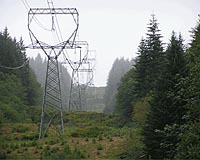 |
Athens, Ohio (UPI) Mar 29, 2009 U.S. scientists say they have created the world's smallest superconductor -- a sheet of four pairs of molecules less than one nanometer wide. The Ohio University-led study is said to provide the first evidence that nanoscale molecular superconducting wires can be fabricated and used for nanoscale electronic devices and energy applications. "Researchers have said that it's almost impossible to make nanoscale interconnects using metallic conductors because the resistance increases as the size of wire becomes smaller," said Associate Professor Saw-Wai Hla of the university's Nanoscale and Quantum Phenomena Institute. Hla, who led the study, said superconducting materials have an electrical resistance of zero, so they can carry large electrical currents without power dissipation or heat generation. Superconductivity was, until recently, considered a macroscopic phenomenon. Hla said the current findings, however, suggest it exists at the molecular scale, which opens up a novel route for studying the phenomenon, The study also provided evidence that superconducting organic salts can grow on a substrate material. "This is also vital if one wants to fabricate nanoscale electronic circuits using organic molecules," Hla said. The research that included Kandal Clark, Sajida Khan, Abdou Hassanien, Hisashi Tanaka and Kai-Felix Braun appears in the early online edition of the journal Nature Nanotechnology.
Share This Article With Planet Earth
Related Links Powering The World in the 21st Century at Energy-Daily.com
 S and C Electric Company Unveils Third-Gen Self-Healing Smart Grid Solutions
S and C Electric Company Unveils Third-Gen Self-Healing Smart Grid SolutionsChicago IL (SPX) Mar 29, 2010 S and C Electric Company has announced an enhanced product and software suite for the intelligent distribution grid featuring IntelliTEAM SG, S and C's 3rd generation Automatic Restoration System. This advanced solution performs fault isolation and rapid self-healing of the distribution system, restoring power in seconds. IntelliTEAM SG also reduces the complexity of deploying advanced dis ... read more |
|
| The content herein, unless otherwise known to be public domain, are Copyright 1995-2010 - SpaceDaily. AFP and UPI Wire Stories are copyright Agence France-Presse and United Press International. ESA Portal Reports are copyright European Space Agency. All NASA sourced material is public domain. Additional copyrights may apply in whole or part to other bona fide parties. Advertising does not imply endorsement,agreement or approval of any opinions, statements or information provided by SpaceDaily on any Web page published or hosted by SpaceDaily. Privacy Statement |